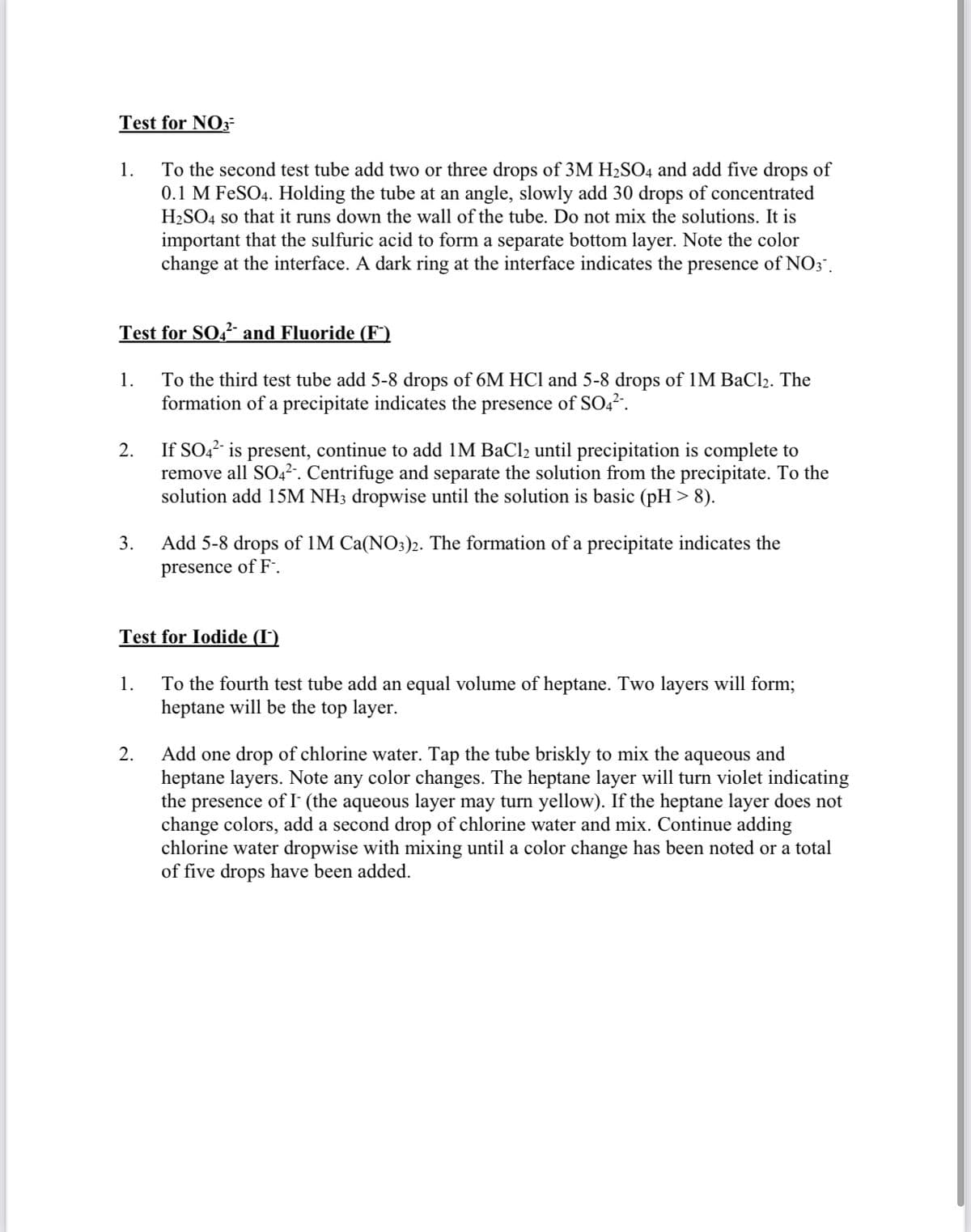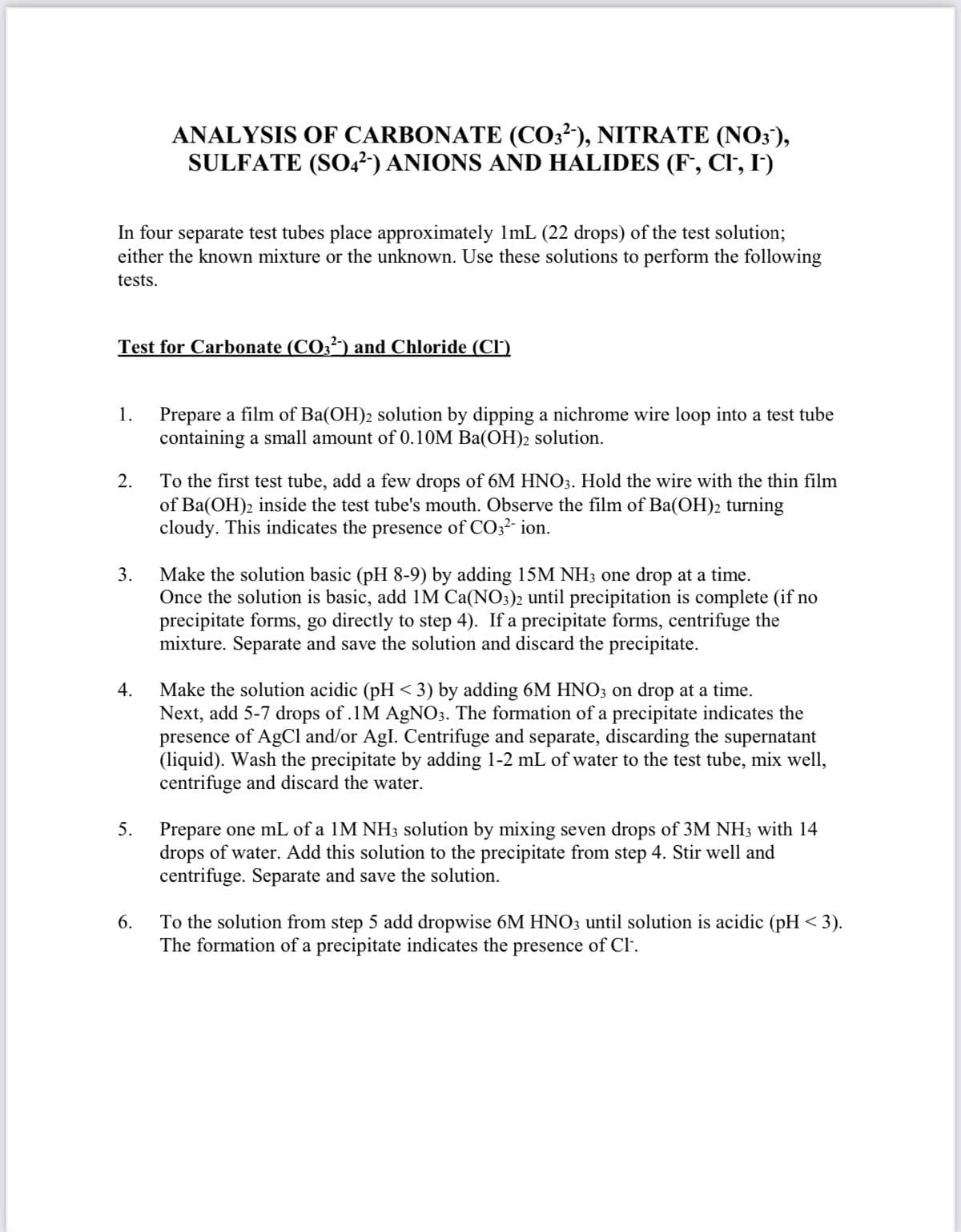Test for Iodide (I') To the fourth test tube add an equal volume of heptane. Two layers will form; heptane will be the top layer. 1. Add one drop of chlorine water. Tap the tube briskly to mix the aqueous and heptane layers. Note any color changes. The heptane layer will turn violet indicating the presence of I (the aqueous layer may turn yellow). If the heptane layer does not change colors, add a second drop of chlorine water and mix. Continue adding chlorine water dropwise with mixing until a color change has been noted or a total of five drops have been added. 2.
Test for Iodide (I') To the fourth test tube add an equal volume of heptane. Two layers will form; heptane will be the top layer. 1. Add one drop of chlorine water. Tap the tube briskly to mix the aqueous and heptane layers. Note any color changes. The heptane layer will turn violet indicating the presence of I (the aqueous layer may turn yellow). If the heptane layer does not change colors, add a second drop of chlorine water and mix. Continue adding chlorine water dropwise with mixing until a color change has been noted or a total of five drops have been added. 2.
Chemistry
10th Edition
ISBN:9781305957404
Author:Steven S. Zumdahl, Susan A. Zumdahl, Donald J. DeCoste
Publisher:Steven S. Zumdahl, Susan A. Zumdahl, Donald J. DeCoste
Chapter1: Chemical Foundations
Section: Chapter Questions
Problem 1RQ: Define and explain the differences between the following terms. a. law and theory b. theory and...
Related questions
Question
Which qualitative test for the identification of an anion was most interesting? Briefly justify your answer

Transcribed Image Text:Test for NO3-
To the second test tube add two or three drops of 3M H2SO4 and add five drops of
0.1 M FESO4. Holding the tube at an angle, slowly add 30 drops of concentrated
H2SO4 so that it runs down the wall of the tube. Do not mix the solutions. It is
1.
important that the sulfuric acid to form a separate bottom layer. Note the color
change at the interface. A dark ring at the interface indicates the presence of NO; .
Test for SO,² and Fluoride (F")
To the third test tube add 5-8 drops of 6M HCl and 5-8 drops of 1M BaCl2. The
formation of a precipitate indicates the
1.
presence
of SO4?.
If SO,? is present, continue to add IM BaCl2 until precipitation is complete to
remove all SO4².. Centrifuge and separate the solution from the precipitate. To the
solution add 15M NH3 dropwise until the solution is basic (pH >8).
2.
Add 5-8 drops of 1M Ca(NO3)2. The formation of a precipitate indicates the
presence of F:.
3.
Test for Iodide (I)
To the fourth test tube add an equal volume of heptane. Two layers will form%;
heptane will be the top layer.
1.
Add one drop of chlorine water. Tap the tube briskly to mix the aqueous and
heptane layers. Note any color changes. The heptane layer will turn violet indicating
the presence of I (the aqueous layer may turn yellow). If the heptane layer does not
change colors, add a second drop of chlorine water and mix. Continue adding
chlorine water dropwise with mixing until a color change has been noted or a total
of five drops have been added.
2.

Transcribed Image Text:ANALYSIS OF CARBONATE (CO3²'), NITRATE (NO3),
SULFATE (SO,²) ANIONS AND HALIDES (F*, Cl, I')
In four separate test tubes place approximately 1mL (22 drops) of the test solution;
either the known mixture or the unknown. Use these solutions to perform the following
tests.
Test for Carbonate (CO3²) and Chloride (CI')
Prepare a film of Ba(OH)2 solution by dipping a nichrome wire loop into a test tube
containing a small amount of 0.10M Ba(OH)2 solution.
1.
To the first test tube, add a few drops of 6M HNO3. Hold the wire with the thin film
of Ba(OH)2 inside the test tube's mouth. Observe the film of Ba(OH)2 turning
cloudy. This indicates the presence of CO32- ion.
2.
Make the solution basic (pH 8-9) by adding 15M NH3 one drop at a time.
Once the solution is basic, add 1M Ca(NO3)2 until precipitation is complete (if no
precipitate forms, go directly to step 4). If a precipitate forms, centrifuge the
mixture. Separate and save the solution and discard the precipitate.
3.
Make the solution acidic (pH < 3) by adding 6M HNO3 on drop at a time.
Next, add 5-7 drops of .1M AGNO3. The formation of a precipitate indicates the
presence of AgCl and/or AgI. Centrifuge and separate, discarding the supernatant
(liquid). Wash the precipitate by adding 1-2 mL of water to the test tube, mix well,
centrifuge and discard the water.
4.
Prepare one mL of a 1M NH3 solution by mixing seven drops of 3M NH3 with 14
drops of water. Add this solution to the precipitate from step 4. Stir well and
centrifuge. Separate and save the solution.
5.
To the solution from step 5 add dropwise 6M HNO3 until solution is acidic (pH < 3).
The formation of a precipitate indicates the presence of Cl.
6.
Expert Solution
This question has been solved!
Explore an expertly crafted, step-by-step solution for a thorough understanding of key concepts.
This is a popular solution!
Trending now
This is a popular solution!
Step by step
Solved in 2 steps

Recommended textbooks for you

Chemistry
Chemistry
ISBN:
9781305957404
Author:
Steven S. Zumdahl, Susan A. Zumdahl, Donald J. DeCoste
Publisher:
Cengage Learning

Chemistry
Chemistry
ISBN:
9781259911156
Author:
Raymond Chang Dr., Jason Overby Professor
Publisher:
McGraw-Hill Education

Principles of Instrumental Analysis
Chemistry
ISBN:
9781305577213
Author:
Douglas A. Skoog, F. James Holler, Stanley R. Crouch
Publisher:
Cengage Learning

Chemistry
Chemistry
ISBN:
9781305957404
Author:
Steven S. Zumdahl, Susan A. Zumdahl, Donald J. DeCoste
Publisher:
Cengage Learning

Chemistry
Chemistry
ISBN:
9781259911156
Author:
Raymond Chang Dr., Jason Overby Professor
Publisher:
McGraw-Hill Education

Principles of Instrumental Analysis
Chemistry
ISBN:
9781305577213
Author:
Douglas A. Skoog, F. James Holler, Stanley R. Crouch
Publisher:
Cengage Learning

Organic Chemistry
Chemistry
ISBN:
9780078021558
Author:
Janice Gorzynski Smith Dr.
Publisher:
McGraw-Hill Education

Chemistry: Principles and Reactions
Chemistry
ISBN:
9781305079373
Author:
William L. Masterton, Cecile N. Hurley
Publisher:
Cengage Learning

Elementary Principles of Chemical Processes, Bind…
Chemistry
ISBN:
9781118431221
Author:
Richard M. Felder, Ronald W. Rousseau, Lisa G. Bullard
Publisher:
WILEY